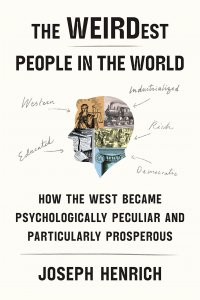My friend Peter tells me he grew up in Kenya with a sense of dislocation. He lived in a society where everything was based on relationships, but he preferred to be alone.
Then he arrived in the United States for his university education, and “I felt immediately at home,” he says. “It was a whole nation of loners.”
Peter was not the first to make the observation, but it has in recent years become a commonplace of evolutionary psychology. The global West differs in important ways from other societies. In fact, the West is downright WEIRD.
And that is the subject of Joseph Henrich’s 2020 bestseller, “The WEIRDest People in the World: How the West Became Psychologically Peculiar and Particularly Prosperous” (Farrar, Straus and Giroux, $35).
At almost 700 pages, the book is a cinderblock of data integrated from many fields of study: psychology, biology, sociology, history, economics, and anthropology, among others.

His thesis is provocative. He proposes that the Catholic Church’s doctrine on marriage, articulated in the fourth century, gradually reconfigured the people of Western Europe, making them more individualistic and less tribal.
It even changed the physical development of their brains. Henrich sums up the difference in the acronym used in the book’s title: WEIRD, which stands for Western, Educated, Industrialized, Rich, and Democratic.
The Church’s disciplines, he argues, have led to unique and unprecedented conditions for human flourishing — a pattern of nonconformity, for example, and creative development in the sciences; new forms of government and laws respecting individual rights and freedoms.
Over the course of centuries, these conditions made possible periods of renewal and revolution such as the Renaissance and the Enlightenment.
The Catholic Church, Henrich argues, was the effective cause at the beginning of this series of events. But that doesn’t mean Catholicism gets credit or blame. He insists: “The church was just the ‘lucky one’ that bumbled across an effective recombination of supernatural beliefs and practices.”
What were the particular doctrines and disciplines that triggered these developments? He focuses on the Christian prohibition of polygamy and cousin marriage — and the Christian promotion of consensual rather than arranged marriage.
These begin to appear in Church legislation just as the Church was emerging from its underground status during centuries of persecution by the Roman Empire.
In 305, eight years before the legalization of Christianity, a synod in the East forbade a widower to marry his sister-in-law or daughter-in-law. The penalty for violators was five years’ excommunication. Over the decades that followed, Christian emperors enacted these as civil laws with similarly severe sanctions, including the death penalty.
The Empire’s Eastern provinces resisted some of these developments, but in the West the new laws gradually supplanted ancient customs and caused a major disruption. Until this time, cousin-marriage had ensured that wealth remained within a clan or tribe, which was distinct and somewhat isolated from other clans and tribes.
Intermarriage led to changes in long-settled laws of inheritance. Wealth could now be distributed more widely. And the focus of societies shifted from clannish identity to the life of the household.
These shifts led to others. At the beginning of the second millennium, canon law and civil law prohibited not only first and second cousins from tying the knot, but even up to the sixth degree. Spiritual kinship also precluded marriage, so godparents were ineligible to marry their godchildren.

Henrich describes in quick summary what transpired over the 500 years that followed.
“As … intensive kin-based institutions dissolved, medieval Europeans became increasingly free to move, both relationally and residentially. Released from family obligations and inherited interdependence, individuals began to choose their own associates — their friends, spouses, business partners, and even patrons — and construct their own relational networks. Relational freedom spurred residential mobility, as individuals and nuclear families relocated to new lands and growing urban communities. This opened a door to the development and spread of voluntary associations, including new religious organizations as well as novel institutions such as charter towns, professional guilds, and universities.”
The evolution was slow, he says, and it thoroughly “renovated” the brains of people who lived by the Church’s vision of marriage. It enhanced neural sectors associated with literacy, for example, and trust of strangers. “Culture can and does alter our brains, hormones, and anatomy, along with our perceptions, motivations, personalities, emotions, and many other aspects of our minds.”
It is clear that Henrich places a positive value on Western WEIRDness, but he does not portray it as superior to other social patterns. In fact, he is sharply critical of colonial and post-colonial efforts to impose Western-style democracy and industry on other cultures.
He observes that peculiarly Western ideas have been baked into the fundamental notions of many professional and academic fields, and then presented to the world as normative. A survey of literature in psychology, for example, revealed that “96 percent of experimental participants were drawn from northern Europe, North America, or Australia, and about 70 percent of these were American undergraduates.”
It is at least questionable whether one-tenth of the world’s inhabitants should be setting the agenda for the vast majority.
Nevertheless, WEIRDness has fueled uniquely rapid progress in the empirical sciences, technology, and social development. WEIRD Westerners have managed to apply their historically eccentric ideas, programs, and structures to the eradication of stubborn problems like hunger and poverty, and achieve astonishing success in a brief space of time.
Henrich sees these as unintentional consequences of the Catholic Church’s long-ago decisions related to marriage.
“The WEIRDest People in the World” is a wonky but compelling story. And, make no mistake, it is a story, a narrative imposed on the available data gathered from many academic disciplines.
Yet it is no less plausible — and not at all inconsistent with Henrich’s account — to believe that God works in and through his Church, and that heaven desires human flourishing and provides for it.
A fundamental tenet of Catholic theology is that grace builds on nature, completes it, and perfects it. Thus, it’s reasonable to conclude that fidelity to God and Church are demonstrably advantageous to people over the long haul.
It may make them different. It may make them weird. But that’s not necessarily bad for them or for the world.
Church leaders may indeed have “bumbled” into this 2,000 years ago, as Henrich describes the transition. But they may have had something greater than luck on their side.

